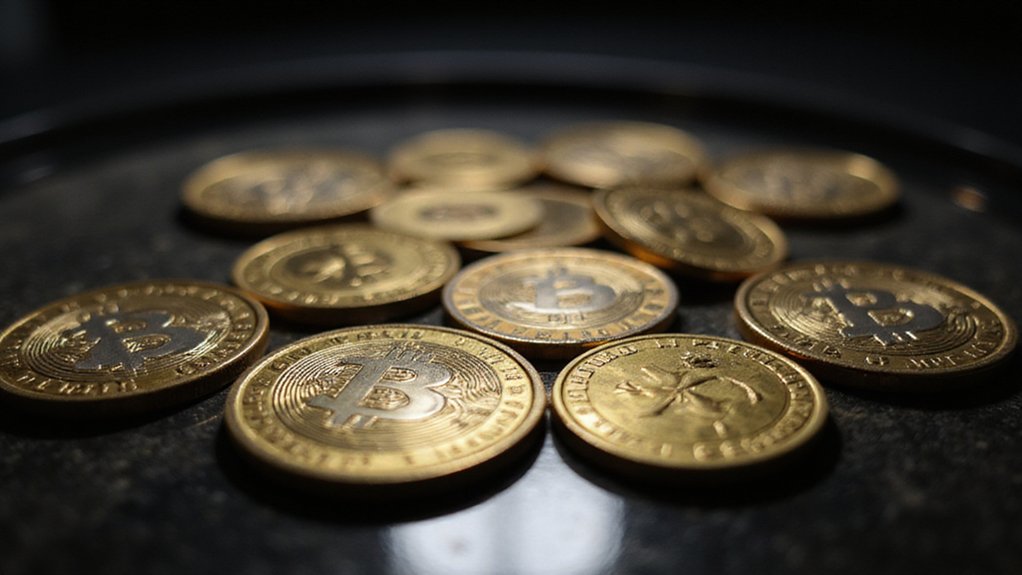Blockchain functions as a decentralized digital ledger where transactions become immutable records distributed across computer networks, eliminating traditional financial intermediaries through cryptographic security and consensus mechanisms. Each transaction gets etched into blocks linked by unique hashes, creating an append-only chain where altering historical data requires changing all subsequent blocks—a computational feat bordering on impossibility. Beyond cryptocurrencies like Bitcoin, blockchain applications span supply chain management, healthcare records, and smart contracts, with public, private, and consortium variations offering different access controls and governance structures for organizations seeking transparency without sacrificing security. The underlying mechanics reveal even more fascinating complexities.

The digital revolution has spawned countless innovations that promise to transform finance, yet few have generated as much simultaneous enthusiasm and bewilderment as blockchain technology.
It is a decentralized digital ledger that operates across networks of computers, eliminating the need for traditional intermediaries while maintaining an immutable record of transactions.
At its core, blockchain functions as a distributed system where data resides across multiple nodes rather than languishing on a single server (thereby avoiding the charming vulnerability of centralized systems).
Blockchain spreads data across multiple computers, cleverly sidestepping the delightful risks of keeping everything in one precarious digital basket.
Each transaction becomes permanently etched into blocks, which link together through cryptographic hashes to form an unbreakable chain—a digital equivalent of carving records into stone, though considerably more sophisticated.
The architecture reveals elegant simplicity: blocks contain transaction details including participants, amounts, and timestamps, while each block references its predecessor through unique identifiers.
This append-only structure means new data joins the party, but existing records remain stubbornly immutable.
Any attempt to alter historical data would require changing all subsequent blocks—a feat roughly equivalent to rewriting history while everyone watches.
Security emerges through cryptographic protection and consensus mechanisms that validate transactions before blockchain admission.
The decentralized nature guarantees no single point of failure exists, making tampering virtually impossible without controlling the majority of network participants (an expensive proposition that would make Bernie Madoff weep with envy).
Blockchain applications extend far beyond cryptocurrencies like Bitcoin and Ethereum.
Supply chain management benefits from tracking goods’ authenticity, while healthcare systems secure medical records through distributed ledgers.
Smart contracts automate agreements, and voting systems gain enhanced security—assuming voters can navigate the technological complexity.
Various blockchain types serve different purposes: public blockchains welcome anyone (democratic yet chaotic), private blockchains restrict access to authorized users (corporate and controlled), consortium blockchains blend public and private elements, while hybrid and federated versions offer organizational flexibility.
The technology promises transparency through visible transactions, immutability via unchangeable records, and efficiency through automated processes. This efficiency largely stems from blockchain’s ability to eliminate traditional intermediaries by facilitating direct peer-to-peer transactions through mutual user consensus. The mining process involves generating cryptographic hashes using a nonce, requiring significant computational effort to validate each block through proof-of-work mechanisms.
Understanding these fundamentals becomes crucial before selecting a crypto exchange or developing any investment strategy in the digital asset space.
Whether blockchain delivers on its revolutionary potential or becomes another overhyped technological curiosity remains to be written—preferably in an immutable ledger.
Frequently Asked Questions
How Do I Buy Cryptocurrency for the First Time?
First-time cryptocurrency buyers should select a reputable exchange like Coinbase or Kraken, complete identity verification (government ID required), and fund their account via bank transfer or debit card.
After choosing a cryptocurrency—Bitcoin or Ethereum being sensible starting points—users specify their purchase amount and confirm the transaction.
The digital assets then reside in the exchange wallet, though transferring to a personal wallet provides enhanced security for substantial holdings.
Is Cryptocurrency Legal in My Country?
Cryptocurrency legality varies dramatically by jurisdiction, creating a patchwork of regulatory approaches that would make even seasoned compliance officers dizzy.
While El Salvador embraces Bitcoin as legal tender and the UAE offers tax-free crypto havens, other nations maintain restrictive stances.
Most developed economies permit trading and holding digital assets, though tax implications differ considerably.
Before purchasing (as previously discussed), one should verify their country’s specific regulations, as legal status can shift faster than market volatility itself.
What Are the Tax Implications of Trading Crypto?
Cryptocurrency trading triggers capital gains obligations that vary dramatically based on holding periods—a temporal distinction that transforms tax liability from ordinary income rates (up to 37%) to preferential long-term rates (maximum 20%).
Short-term trades face punitive ordinary income treatment, while patient holders enjoy capital gains benefits.
Every transaction requires meticulous documentation for IRS compliance, as regulators increasingly scrutinize digital asset activities with the fervor typically reserved for offshore accounts.
How Do I Store My Cryptocurrency Safely?
Cryptocurrency storage follows the fundamental principle that convenience inversely correlates with security.
Cold wallets—hardware devices like Ledger Nano X or Trezor Safe 3—provide ideal protection for substantial holdings, while hot wallets facilitate frequent trading.
Diversification across multiple storage methods, regular backups, and strong passwords constitute essential practices.
One might consider the irony that digital assets require decidedly analog security measures for maximum protection.
Can I Lose All My Money Investing in Crypto?
*Previously discussed security protocols remain essential but insufficient protection.









